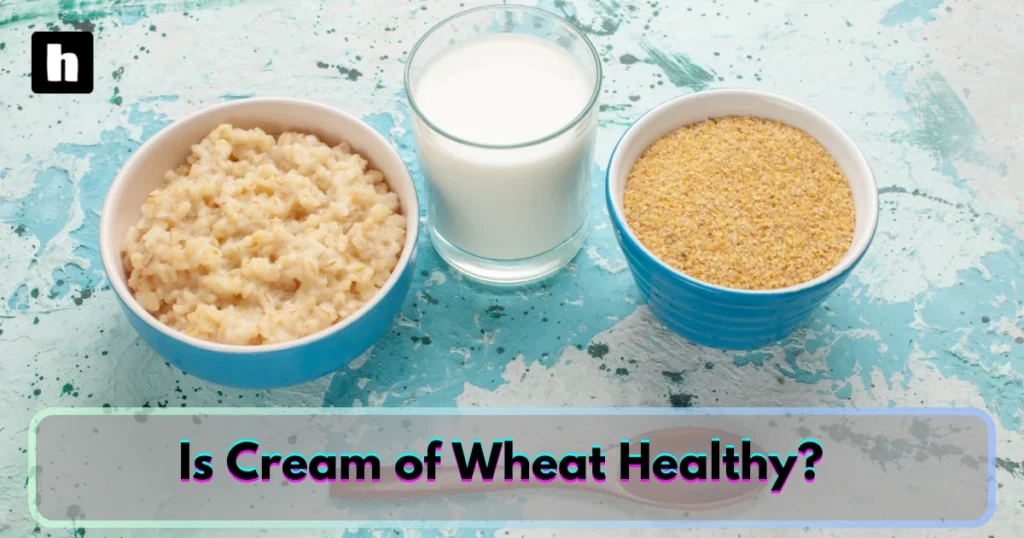
Cream of wheat, a widely consumed breakfast option, that has been a staple in households for generations.It is prepared using finely ground wheat flour. Typically, it is mixed with either milk or water. Although cream of wheat is favored by many, its nutritional value as a component of a well-rounded diet remains uncertain. But is it really good for you? In this Article, we’ll delve into the nutritional benefits, potential drawbacks, and overall health implications of consuming Cream of Wheat regularly.
Is cream of wheat good for you
Yes, if you include cream of wheat in your diet in a balanced manner, it can be beneficial to you. Fast energy, vital nutrients like protein and fortified vitamins, and adaptability to different dietary preferences are all provided by it. For added fiber and nutrients, it’s crucial to watch out for added sugars in flavored varieties and to think about whole grain substitutes. Gluten-free options are the better choice for those who are sensitive to gluten. In general, to fully benefit from Cream of Wheat, moderation and well-balanced meal planning are essential.
Benefits of cream of wheat
1. Sources of Minerals and Iron
Cream of Wheat offers a multitude of advantages, with its high iron content being one of the most notable. By providing 58% of the Daily Value (DV), it plays a crucial role in preventing anaemia and addressing other health concerns associated with iron deficiencies.
In addition to its iron content, Cream of Wheat serves as an excellent source of other vital minerals like calcium, selenium, and copper. These minerals play key roles in supporting various bodily functions, including the development of strong bones and teeth, bolstering the immune system, and facilitating energy production.
2. Moderate Protein Content
The protein content in Cream of Wheat is moderate, serving as a significant factor in promoting muscle repair, growth, and overall bodily functions. Although it may not offer the same protein concentration as eggs or Greek yogurt, it still contributes to your daily protein consumption.
3. Rich in nutrients
When we describe Cream of Wheat as “rich in nutrients,” we are highlighting its abundance of essential vitamins and minerals that are beneficial for our health. Specifically, Cream of Wheat is fortified with nutrients like iron, calcium, and various B vitamins, such as niacin, thiamine, and riboflavin. These nutrients play crucial roles in important bodily functions like energy metabolism, bone health, and the production of red blood cells.
Moreover, Cream of Wheat provides carbohydrates for energy and protein for muscle repair, making it a well-rounded choice for breakfast. Overall, the term “rich in nutrients” indicates that Cream of Wheat offers a comprehensive array of essential nutrients necessary for maintaining overall health and well-being.
4. Quick Energy Source
Cream of Wheat consists mainly of carbohydrates, offering a rapid supply of energy, which makes it a perfect option for breakfast or a pre-workout meal.
Drawbacks
Added Sugars
Some flavored Cream of Wheat varieties might have added sugars, which could offset some of its health benefits and lead to an excessive calorie intake. It’s critical to carefully read labels and, if at all possible, select plain or unsweetened varieties.
Includes gluten
Cream of Wheat is derived from wheat semolina, a gluten-containing ingredient. It is classified as farina, a cereal produced by milling wheat. Consequently, cream of wheat inherently contains gluten, a collection of proteins present in cereal grains that imparts the characteristic stretchiness to dough. Although the majority of individuals can consume gluten without any problems, those with celiac disease or gluten sensitivity may encounter unfavorable reactions upon consuming gluten-rich foods.
Low Fiber Content
While cream of wheat does provide carbohydrates and protein, it typically falls short in terms of fiber when compared to whole-grain cereals. Enhancing fiber consumption is crucial for maintaining a healthy digestive system and may aid in the prevention of certain chronic diseases.
High in Sodium
The sodium content in Cream of Wheat can be significant, and consuming it excessively may result in health complications like high blood pressure and cardiovascular ailments. Hence, it is essential to keep a close watch on sodium intake and select low-sodium options whenever feasible.
Frequently Asked Questions
Q1: Is cream of wheat full of protein?
A1: A great way to get the nutrition you need is to try Cream of Wheat Whole Grain. Every hot, filling bowl is a good source of protein.
Q2: Is it good to eat cream of wheat every morning?
A2: The nutritional profile of Cream of Wheat is abundant in B vitamins, which are crucial for promoting overall well-being.
Q3: Does cream of wheat burn fat?
A3: No, Cream of Wheat doesn’t burn fat. It’s part of a balanced diet, but fat loss requires a calorie deficit through diet and exercise.
Q4: Is cream of wheat better with water or milk?
A4: Cream of Wheat can be enjoyed with either water or milk, depending on personal preference.
The Bottom Line
While cream of wheat offers benefits such as quick energy and essential nutrients, it’s important to be aware of potential drawbacks. By incorporating it into a balanced diet and making thoughtful choices, individuals can enjoy cream of wheat as part of a healthy lifestyle.


